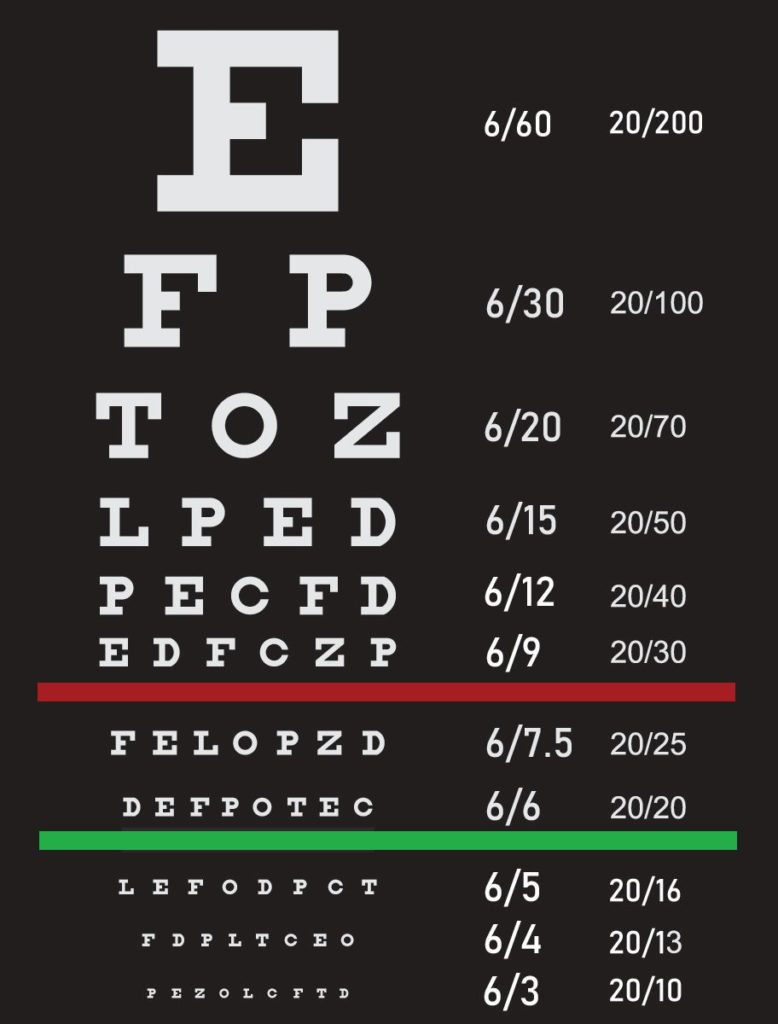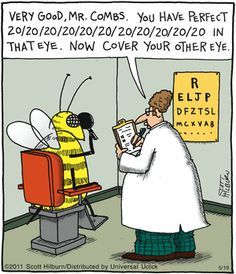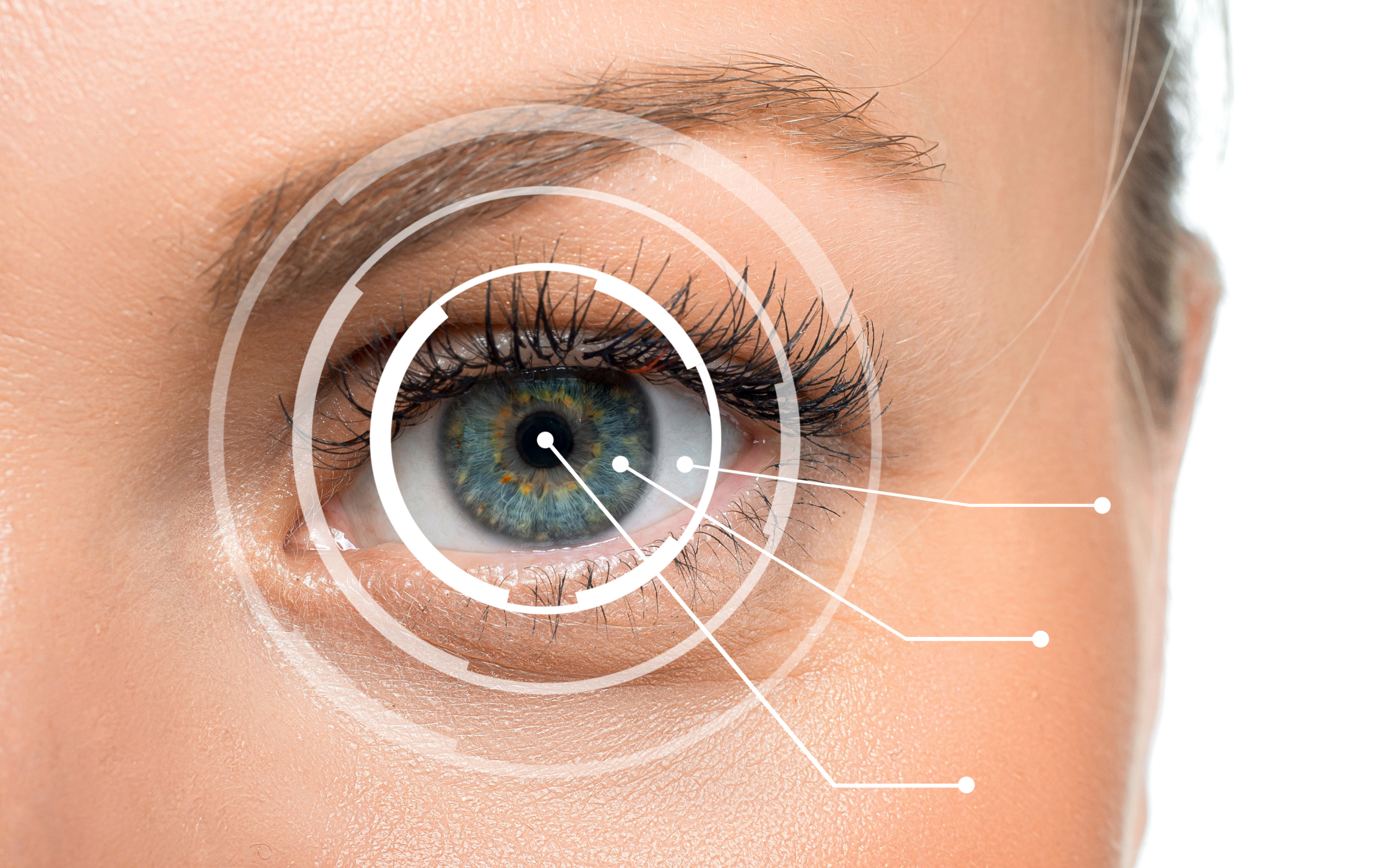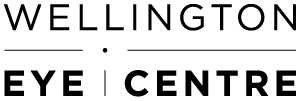
Wellington Eye Centre Optometrist
The year is 2020, there are vision related puns and memes all over the internet. But what does it mean to have 20/20 vision?
People use the term 20/20 vision a lot, and they tend to think it means “perfect vision”, but it actually means “normal visual acuity”. Visual acuity is the clarity or sharpness of vision when measured on a standard letter chart.
So if your eye care practitioner says you have 20/20 vision, it means at a distance of 20 feet, you can accurately identify the same sized letters as someone with “normal” vision.
Someone whose vision is worse than “normal” may have their vision documented as 20/30, meaning at 20 feet they can identify letters that someone with normal vision would see at 30 feet.
There are quite a few people who can see better than 20/20, and their vision might be documented as 20/10. Someone with 20/10 vision, means that on the standard letter chart they can see three lines of letters smaller than someone with normal vision. Or at 20 feet they can see something that someone with normal vision can only see if they move closer to the chart, 10 feet.
American or British?
20/20 is actually an American measurement. In most other nations, like New Zealand and Australia, we use the metric system for recording distances. So for vision testing we would say; 6/6. So instead of the chart being 20 feet away, the chart is 6 metres away. 20/20 and 6/6 represent the same sized letters, they just use different measuring systems to document the results.
America hasn’t switched to the metric system, so it still uses charts based on feet, rather than on meters. Just like America is one of the only nations still using Fahrenheit rather than degrees Celsius to record temperature.

Why is 20/20 vision so important?
Well on a day to day basis it may not be as important as we think it is. Using the letter chart is one way, and the simplest way of assessing a person’s quality of vision. But it really only determines how good your vision is in a very static way. Other aspects of our vision have a huge impact on how we see and navigate our day to day life. Vision is far more complex than just being able to see black letters on a white chart!
Peripheral vision
Peripheral vision is very important, and it can’t be measured on a letter chart. This is your ability to see out the sides of your eyes, it helps you place yourself in space. Without good peripheral vision you might walk into low tables, chairs, find yourself missing steps or accidentally standing on pets. Peripheral vision is really good at detecting movement rather than fine details. This ability to detect movement is what helps protect us from dangerous objects that might be hurtling toward us, especially in busy environments like crossing streets.
Eye co-ordination and muscle movement
How well our eyes are coordinated is also important. The muscles of our eyes coordinate our eye movement and the focusing of our eyes. These muscles are hugely beneficial to help us judge depths, speed and the fine movements required to scan lines of reading material. These muscles also enable our eyes to change focus from distant to near objects. As you are reading this article, those muscles are working hard to keep the type in focus. Other muscles of the eye are now allowing you to scan from word to word across the line, and then the highly detailed action of jumping from one line, down to the next.
Colour vision
Your colour vision is also not measured on the standard letter chart, and it helps you distinguish many objects on a day to day basis. Is that fruit still OK to eat? Can you see a rash on your arm? Is that a green light, can I cross the road now?
Can someone who needs spectacles still have 20/20 vision?
Any measurement of vision needs to be specified as to how that vision was achieved.
Unaided Vision is the level of vision you achieve with no help from any visual correction device. So with no contact lenses or spectacles.
Aided vision is the vision you achieve with your spectacles or contact lenses on.
Best corrected vision is the vision you achieve at the time of your eye test, wearing the best possible spectacle or contact lens prescription for you.
So you might be able to achieve 20/20 vision with no spectacles or contact lenses, or you may only achieve it when you wear your visual correction.
Optometrists aim to correct your vision to the lowest possible line of letters you can achieve. For some people that may mean they can only get to 20/30, others eyes might have the capability to see even better than 20/20.

You have 20/20 vision, that’s great!
It is great to have clear vision, but don’t forget, even people with normal or above average vision still need the health of their eyes checked. Some eye diseases do not alter your vision till much later in the disease process, such as glaucoma. Early detection is paramount in these conditions. Factors such as age, family history and pre-existing health conditions e.g diabetes affect how often you should get your eyes tested.
How common is 20/20 vision?
American statistics from the University of Iowa indicates about 35% of adults can achieve 20/20 vision without correction. But with correction, that level jumps to 75%. But only 1% of the general population can achieve 20/15.
Indigenous peoples have some of the best visual ability in the world. In particular, Australian Aboriginals have been recorded to have far superior vision compared to non-indigenous Australians. One individual was tested to have acuity of 20/5.
Not only do Australian Aboriginals have lower rates of short sight and astigmatism, it seems the neural wiring between their brains and eyes is significantly more refined than found in other races.
Can I achieve 20/20 vision with laser vision correction?
In Laser Eye Surgery, the surgeon’s goal is to get your vision without glasses after surgery to the same level as your “best corrected visual acuity” (with glasses or contact lenses) before surgery, or better.
When optometrists or surgeons say “gaining or losing a line of vision”, they mean the change in ability to read a line on the eye chart without glasses after surgery, from the ability to read the line with glasses, before surgery.

What does it mean if you can’t achieve 20/20 vision?
If you aren’t quite achieving 20/20 vision, it may not affect you all that much, it depends a lot on what you do for a job or your hobbies. You may not even realise your vision is less than 20/20.
In New Zealand you need to see at least 6/12 (or 20/40) with both eyes open to obtain a standard driver’s licence. And if you can only reach that level of vision with your vision correction, that is OK.
Some careers require you to pass certain standards of vision. For example to have a passenger endorsement or a heavy vehicle endorsement on your driver’s licence you will need to achieve 6/9 (20/30) either with or without vision correction.
Pilots (commercial and non-commercial), Police Officers, members of the Defence Force and Seafarers (People working in the commercial maritime industry) all have specific visual requirements to meet. They have to pass certain standards in visual acuity (the letter chart), colour vision and peripheral vision.
In New Zealand, if your corrected vision is 6/24 or less or your peripheral vision is significantly reduced to less than 20 degrees you are eligible to access the fabulous services of Blind Low Vision NZ (formerly the Blind Foundation).
The term ‘legally blind’ can refer to someone whose vision, with correction (spectacles or contact lenses) is worse than 6/60 (20/200) or if their peripheral vision is significantly reduced.
If you have any other questions or wish to book a consultation with Dr Logan, get in touch with the team at Wellington Eye Centre. You can call us on 0800 733 327 or complete the contact form below.

Amblyopia and Laser Eye Surgery

What are the visual requirements to join the Police in NZ?

What Can Go Wrong During Your Laser Eye Surgery?

What are the visual requirements for flying, set by the Civil Aviation Authority?

What happens when your vision after laser vision correction surgery is not what you expected?

Everything You Need To Know About Dry Eye

What to expect during your Laser Suitability Medical Assessment at Wellington Eye Centre

Low-Level Light Therapy for Dry Eyes

Common Medications Used in Laser Eye Surgery

